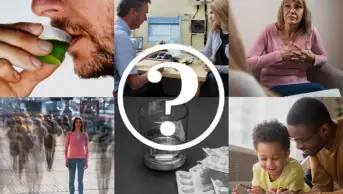
Federico Caputo / Alamy Stock Photo
In early January 2015 my daughter attended the funerals of two male friends. They didn’t know one another; they lived in different parts of the south of England. Both had died by suicide.
Suicide is now the highest cause of death in men under the age of 50 years in the UK. In 2015, there were 6,188 deaths registered as suicides in the UK. And while this showed a decrease in the number of men who had died by suicide, it was the highest rate for women in a decade. Across all age groups, the rate for men was three times higher than for women[1]
.
The National Suicide Prevention Strategy has identified a number of high-risk groups[2]
:
- Young and middle-aged men;
- People in the care of mental health services, including inpatients;
- People in contact with the criminal justice system;
- Specific occupation groups, such as doctors, nurses, veterinary workers, farmers and agricultural workers;
- People with a history of self-harm.
Risk factors include drug and alcohol misuse, history of trauma or abuse, unemployment, social isolation, poverty and poor social conditions.
In 2015, the most common method of suicide in the UK was hanging (58% of men and 48% of women), with the second being poisoning (18% of men and 35% of women).
The need to address the high risk of suicide in men is now being recognised
Analysing the National Statistics, Hawton et al. found that a reduction in pack size of paracetamol resulted in fewer deaths from paracetamol poisoning[3]
. However, a study by Molloy et al. showed that mystery shoppers were still able to buy multiple packs of paracetamol-containing products[4]
.
The need to address the high risk of suicide in men is now being recognised and a number of campaigns and charities aimed at male-specific groups are trying to get messages and support out to these groups.
The 2012 report by the Samaritans, “Men, suicide and society: why disadvantaged men in mid-life die by suicide”, highlighted a lack of social support mechanisms leading to social isolation as a contributing factor in the higher rate of suicide in adult men[5]
.
The Campaign Against Living Miserably (CALM) is dedicated to preventing male suicide[6]
. Launched as early as 1997 as a pilot by the Department of Health in Manchester, CALM aimed to support men aged 15–35 years through sport, music and the club scene. However, in 2011, it was realised that the majority of their calls were from men over 35 years, and they now support men of all ages.
So how can we, as pharmacists, get involved in preventing suicide?
In 2003, pharmacist Patrick Thorp founded Pharmacists Preventing Suicides in the US state of Missouri[7]
. The organisation provides education, research, training and lobbying, and promotes practical and proven tools to assist the pharmacy profession in preventing suicide.
Mystery shoppers were still able to buy multiple packs of paracetamol-containing products
In the Canadian province of Quebec, the Faculty of Pharmacy at the Université de Montréal provides suicide prevention training to third-year students. The training sessions started in 2010; since then, there has been an increase in the number of pharmacists calling the Regional Suicide Hotline to validate their interventions[8]
.
The Washington State Department of Health has approved suicide prevention training for pharmacists, with all state-registered pharmacists expected to undertake the training in the next year. The three-hour session will include steps to identify and prevent suicide.
So what are we doing in the UK? There is no published evidence of any similar initiatives.
The New Medicines Service does not extend to antidepressants, but this should not stop community pharmacists and their teams from monitoring and signposting to services that can offer support. Pharmacists should advise patients who have been newly prescribed antidepressants that they will not experience a reduction in symptoms immediately and that it may take some weeks. While the increased risk of suicidality and aggression remains a controversial subject, and there has yet to be any conclusive evidence to support this in adults[6]
, patients should be warned to report any such symptoms to the prescriber as soon as possible[9]
.
Community pharmacists will see many patients with long-term debilitating illnesses who are at risk of suicide
There also needs to be a recognition that it is not just those being actively treated for depression who are at risk. Community pharmacists will see many patients with long-term debilitating illnesses who are at risk of suicide. Recently published research from Canada revealed that suicidal thoughts and behaviours are common among adolescents and young adults with chronic illness, particularly among those with comorbid mood disorders[10]
.
Pharmacists and counter staff should not be afraid to ask patients how they are feeling when they are collecting medication, and encourage them to seek help if their mood is becoming low.
It is estimated that one in six people are living with mental health issues[11]
. Are pharmacists in the UK worried that they are not suitably equipped with the skills to help people with mental health problems? Or is it that the work is going on and not being recorded or shared within the profession? Hopefully, antidepressants will be added to the New Medicines Service and we will see more suicide awareness in the future.
Vilma Gilis, lead pharmacist, Kent & Medway Partnership Trust
References
[1] Office for National Statistics. Suicides in the UK: 2015 registrations. Newport:2016. Available at: https://www.ons.gov.uk/peoplepopulationandcommunity/birthsdeathsandmarriages/deaths/bulletins/suicidesintheunitedkingdom/2015registrations (accessed December 2017)
[2] HM Government. Preventing suicide in England: third progress report of the cross-government outcomes strategy to save lives. 2017. Available at: https://www.gov.uk/government/uploads/system/uploads/attachment_data/file/582117/Suicide_report_2016_A.pdf (accessed December 2017)
[3] Hawton K, Bergen H, Simkin S et al. Long term effect of reduced pack sizes of paracetamol on poisoning deaths and liver transplant activity in England and Wales: interrupted time series analyses. BMJ 2013;346:f403. doi: https://doi.org/10.1136/bmj.f403
[4] Molloy P, Chambers R & Cork T. How well are national guidelines relating to the general sales of aspirin and paracetamol, adhered to by retail stores: a mystery shopper study. BMJ Open 2016;6(1). doi: http://dx.doi.org/10.1136/bmjopen-2015-010081
[5] The Samaritans. Men, suicide and society: why disadvantaged men in mid-life die by suicide. Available at: https://www.samaritans.org/sites/default/files/kcfinder/files/press/Men%20Suicide%20and%20Society%20Research%20Report%20151112.pdf (accessed December 2017)
[6] Campaign Against Living Miserably (CALM). Available at: https://www.thecalmzone.net (accessed December 2017)
[7] Pharmacists Preventing Suicides, Inc. Available at: htttp://pharmacistspreventingsuicides.com (accessed December 2017)
[8] Murphy AL, Gardner DM, Chen TFet al. Community pharmacists and the assessment and management of suicide risk. Can Pharm J 2015;148(4);171–175. doi: 10.1177/1715163515587554
[9] Sharma T, Schow Guski L, Freund N et al. Suicidality and aggression during antidepressant treatment: systematic review and meta-analyses based on clinical study reports. BMJ 2016;352. doi: https://doi.org/10.1136/bmj.i65
[10] Ferro MA, Rhodes AE, Kimber M et al. Suicidal behaviour among adolescents and young adults with self-reported chronic illness. Can J Psychiatry Online First. doi: 10.1177/0706743717727242
[11] McMnaus S, Bebbington P, Jenkins R et al. Adult psychiatric morbidity survey: survey of mental health and wellbeing, England, 2014. Leeds: NHS Digital. Available at: http://content.digital.nhs.uk/catalogue/PUB21748/apms-2014-full-rpt.pdf (accessed December 2017)


